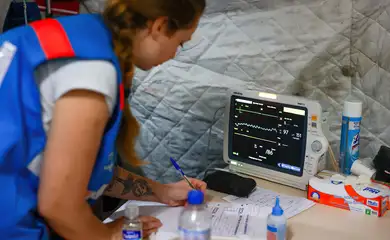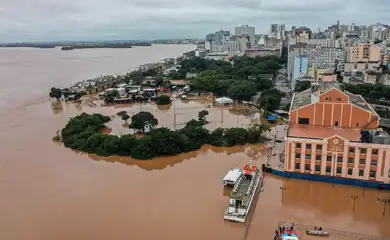Public radio reaches power-deprived areas in Brazil’s South

A device many believe to be outdated has regained its vital role amid the floods that have wreaked havoc on hundreds of cities in Rio Grande do Sul, South Brazil. Following power outages and the loss of internet signals, a large portion of the state’s population have once again opened their ears to the information transmitted by the old battery-operated radio.

Aware of the potential of this crucial tool for communications, Brazil’s public broadcasting company EBC has pointed one of its shortwave transmitters at the region. As has long been the case for North Brazil, EBC has given people a chance to reunite and gain access to basic services in times of dire need since late April.
A resident of the city of Canoas, 62-year-old janitor Belmiro Prates is one of the victims of the floods. The entrance to the building where he lives was invaded by waters, leaving his car completely submerged. He was rescued on Monday 13 by a Civil Defense team. Since then, with no access to power, telephones, or the internet, Prates has struggled to stay informed and to notify his loved ones of his situation.
The trusty old devices, he believes, have the power to overcome barriers for people with no TV or electricity, and have become the main form of communication. “I only managed to keep up to date here thanks to the radio and the programs on Rádio Nacional station. I have acquaintances in Amazonas [state], and it was thanks to the interview I gave that I was able to send a message to everyone saying I’m fine,” he told Agência Brasil.
It was also through the radio that Prates could learn important information about the weather forecast and the conditions in other areas where his family members live.
Radio worker and Porto Alegre resident Rafa Hotto used social media to comment on the role of radio amid the tragedy. “Yesterday, at a terrible time for our state, with no electricity, water or internet, I tuned in to my good old friend Rádio Nacional da Amazônia, just as the presenter was sending a message of strength to the people of Rio Grande do Sul [state]. I’ve been a communicator for 24 years and I’m really passionate about radio. I confess, friends, sometimes we don’t realize how many thousands of people in the most remote places are following us. That’s radio.”
The main form of communication
Belmiro Prates sees the tragedy in Rio Grande do Sul as a reason to reconsider many aspects of this means of communication. “It goes beyond entertainment. It’s clear that short and medium waves are more useful than ever, and this needs to be explained to people,” he argued.
Shortwave radio makes it possible to tune in to stations in remote areas. Unlike AM and FM radios, which use longer waves, shortwave radios use waves that can reflect off the ionosphere, the electrified layer of the Earth’s atmosphere. This enables the signal to travel over longer distances, sometimes reaching listeners on other continents.
Communication difficulties are not restricted to cutting-edge internet-based technology. “Even for those who are radio amateurs it’s difficult to communicate, because our equipment needs a lot of energy,” telegrapher, electronics technician, and radio enthusiast Cianus Luiz Colossi told Agência Brasil.
Former head of the Relay Department at Rio Grande do Sul’s educational channel TV Educativa, Colossi believes the tragedy casts light on the need for Brazil to have more concrete strategies in place to deal with communication challenges at critical moments like this.
“The country needs to review its national emergency network from a more technical point of view. Basic telephony as we know it has collapsed here in the state. And, incredible as it may seem, the lack of incentives from the governments that have succeeded each other over the last few years has also ended up reducing the capacity and the initiative of amateur radio networks in Brazil,” he went on to say.
From the North to the South
By directing a shortwave transmitter to the southern state of Rio Grande do Sul, EBC has brought back to the region “the essence of what shortwave means for society,” explained Thiago Regotto, the company’s executive manager for radio.
“We had already been doing the programs that were originally just for the Amazon, but with last weekend’s adjustment on the antennas, we started doing exclusive tracks to reach the people of Rio Grande do Sul,” he stated.
As a state-owned company controlling most of Brazil’s shortwaves, EBC, he said, is providing local broadcasters with access to key informative radio content via shortwave, streaming, and satellite, as well as serving as a space for listeners to interact and share their reality.
“We give space to experts and news through this tool, which is the only one that works now that several cities are without electricity. Information is transformative,” he noted. “Talking from traditional experience, radio is a partner,” he added.
“In situations like these, [radio] really becomes the right and left arms [of the people]. It’s enough to have a little battery-operated radio to have content that really makes a difference.”
A bridge between people
The content aired on Rádio Nacional features experts and people going through difficulties, Regotto remarked. “There is also a lot of contact between listeners. What we used to do on shortwave for the Amazon, we’re now doing on shortwave for Rio Grande do Sul,” he added, referring to programs like Ponto de Encontro, on Rádio Nacional da Amazônia, hosted by Edileia Martins—Didi Martins, as she is called by her most regular listeners.
“Ponto de Encontro is an inspiring program dedicated to creating a space that not only informs, but also connects and strengthens people through information. We pass on messages from people who need to speak to their families. It’s a kind of bridge between listeners. This interaction is among its most rewarding aspects. I listen to stories and respond to needs, creating really special bonds and contributing to the appreciation of people as citizens,” she explained.
Didi Martins sees similar the potential of these capabilities in helping the victims of the floods in Rio Grande do Sul. “Anyone who needs to send a message, whether it’s to say that everything is fine, to talk about their needs or even to have a place of affection, welcome, friendship or whatever else on the radio—they can count on us,” she added.
Relay
With a green light given by EBC, the programs aired on Rádio Nacional can also be reproduced by other stations for the duration of the public calamity in the state.
Rádio Nacional’s shortwave coordinator for the Amazon and Rio Grande do Sul, Taiana Borges, noted that the interest of several stations in using EBC contents was immediate and took on a larger proportion than anticipated.
“The [program] Sintonia com o Sul airs from 7 to 7:30 am and from 5 to 6:30 pm. It features news, services, weather forecasts, alerts, including reports on the situation of rivers in the South, interviews, and all kinds of information that can help the people of Rio Grande do Sul at this time of public calamity,” she explained, referring to the program that runs on the 6,180 kHz and 11,780 kHz shortwave frequencies.
A shortage of battery-operated radios
The situation in the South has also cast light on another problem: There is a shortage of battery-operated radios in Brazil. “Today we see the need to stimulate the manufacture of this device, in a bid to improve the use of shortwaves in emergency situations such as the current one in Rio Grande do Sul,” Taiana Borges argued.
In the meantime, she suggests that people donate battery-operated radios to the flood victims. She cited initiatives such as those adopted by some universities in the South. “There’s an interesting campaign being run by the University of Santa Cruz do Sul (Unisc), in partnership with the Federal University of Santa Maria (UFSM). They are collecting and distributing battery-operated radios in municipalities affected by the floods, which have lost their internet signal or power,” she said.




